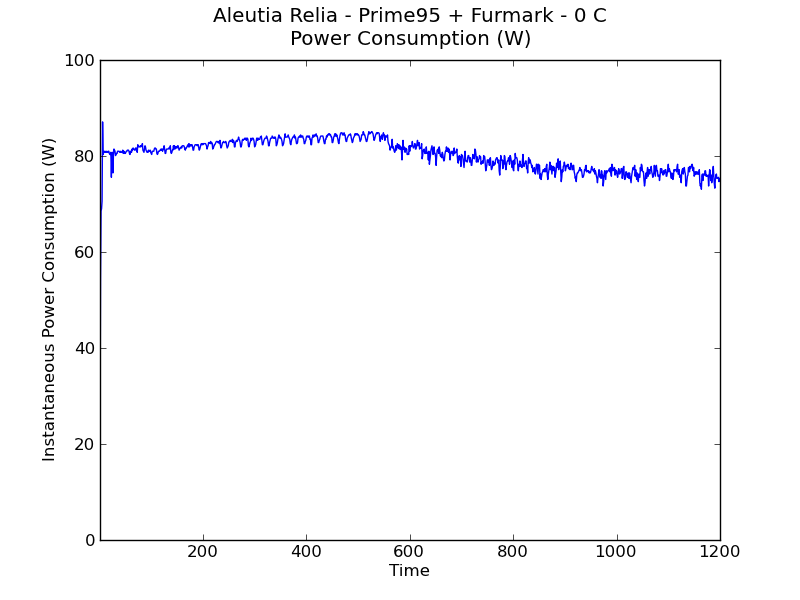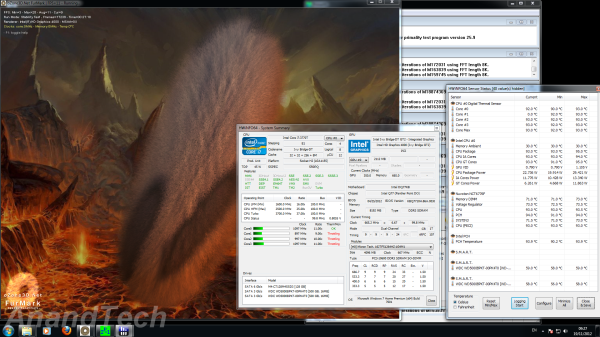Aleutia Relia Industrial PC Review: Ivy Bridge & Q77 in a Fanless Chassis
by Ganesh T S on December 4, 2012 10:00 AM EST- Posted in
- Industrial PC
- HTPC
- Ivy Bridge
- Aleutia
Thermal Performance:
One of the drawbacks of completely passively cooled systems is that the CPUs reach their maximum temperature much faster than actively cooled systems. The CPU throttles down its performance as soon as the limits are reached. We proceeded to test out the thermal performance by loading up both the CPU and GPU with Prime 95 and Furmark. After hitting the thermal limits, the CPU speeds were throttled to 900 MHz.
One of the points to note in the above screenshot (taken with the unit at room temperature - 72 F) is that the chassis becomes hot enough for the HDDs to report a temperature of 59 C. This is even without any hard drive activity in the loading process. 55 - 60 C is considered the maximum permissible temperature for hard disks to ensure reliable operation. It doesn't seem advisable to use mechanical hard disks in the system if it is expected that the workloads for the system would end up throttling the CPU. We pinged Aleutia about this, and they indicated that the advisable ambient temperature for our test system was 30 C (for a pure SSD only solution, they upped it to 33 C). They also indicated that the i3-based system could go higher in terms of ambient temperature, but didn't mention specifics. For users with a requirement for operation at higher ambient temperatures, Aleutia indicated that they have custom solutions available too.
Our next plan of action was to determine the efficiency of the thermal solution under the above constraints. To test this out, we placed the unit in a temperature chamber and recorded the power consumption under full load. As soon as throttling hits, the power consumption of the unit starts to drop. We repeated the test with the temperatures at 0 C, 15 C and 30 C. After each run (i.e, subjecting the unit to full loading and letting the CPU cores reach the Tjmax of 94 C), we let it idle for 30 minutes. The core temperatures after the idling with the ambient at different temperatures are provided below.
| Aleutia Relia Cooling Efficiency | |
| Ambient Temperature | Core Temperature 30 min. after Tjmax |
| 0 C | 31 C |
| 15 C | 36 C |
| 22 C | 39 C |
| 30 C | 51 C |
The power consumption graphs are provided below for the unit's operation over a 20 minute duration after the start of the loading process.

The thermal solution works very well at low temperatures, with throttling kicking in after 9 minutes or so. With rising ambient temperature, the throttling kicks in within 3 minutes (at 30 C). These graphs are with absolutely no air flow in the temperature chamber, and are hence, worst case scenarios.
At 30 C, we also have detailed graphs of the temperature, load and frequency for one of the cores. These were generated by CoreTemp 1.0 RC4.












47 Comments
View All Comments
Rick83 - Tuesday, December 4, 2012 - link
I see you mention the NIC on the last page (might have been better placed on the first page, where you list the components), so the hardware is there.Is BIOS support there as well?
Haven't seen anything from the BIOS so far, and AMT is heavily dependant on entire-system support.
Did you actually get a KVMoIP session to work?
While this particular model is not that interesting to me, I am looking generally into systems with AMT support, so getting to know the functionality that each vendor provides is quite interesting.
jhh - Tuesday, December 4, 2012 - link
I suspect a slower RAM was selected to work in a fanless device, but if you had an IR camera, it would have been nice to confirm device temperatures. The case top probably adds to the case heat-sink capacity, so removing the top could cause problems with the processor and its heat-pipe to the case, which would make it difficult to take such a picture.Minion4Hire - Wednesday, December 5, 2012 - link
That doesn't seem likely. There's not much in the way of chassis ventilation and the heatpipes connect directly to those side heatsinks. If anything temperatures should drop with the cover removed as less heat can be trapped inside of the chassis, although in a temperature controlled testing environment with zero airflow it might not really matter.Googer - Monday, December 17, 2012 - link
Cooling isn't necessary DDR3 1600 as most ram chips generate very little heat. Modern day DIMM salesmen add heatspreaders and heatsinks, mostly as a marketing ploy.cjs150 - Tuesday, December 4, 2012 - link
I have recently built a very similarly spec HTPC (using the HDplex case rather than what I guess is a streamcom/wesean case) so it was nice to see a comparison. Price is a lot more reasonable than my build.i7-3770T works extremely well as an HTPC (shame about screen refresh rate - Intel should hang their heads in shame)
Personally I would not use a mechanical hard disc, I hate noise and for an HTPC, an SSD is fine.
The problem as I see it for an HTPC is that if no optical drive or TV tuner why bother with something this complex, probably easier and cheaper to store all the media on a NAS and have a very cheap streaming device as the HTPC.
After saying that, none of the fanless cases I have looked at that support an optical drive give any thought to noise dampening the drive.
Kevin G - Tuesday, December 4, 2012 - link
Looking at the internal layout, I can easily see why the hard drives get hot: one is mounted directly over the CPU. I wonder how just a single hard drive mounted over the memory performs with regards to temperatures and throttling.It also looks like the Wi-fi chip is replaceable so that single band disadvantage can be rectified.
My only other complaint would be the 19V external power supply. It would have been nicer to see a 12V external PSU or even an internal PSU to avoid a power brick entirely. Minor quibble in the grand scheme of things.
Guspaz - Tuesday, December 4, 2012 - link
The as-configured price seems to be at least $500 overpriced. This thing has a BOM somewhere around $900ish at *RETAIL* pricing (I made a list), $1500 for the machine is ridiculous.mrdude - Tuesday, December 4, 2012 - link
Poor WiFi that only offers single-bandNo card reader
No Bluetooth
Aaaaand somehow this is supposed to be an HTPC? viable small form factor PC? At that price? say what?
These people must be kidding themselves.
A5 - Tuesday, December 4, 2012 - link
No, this is designed to be used in an industrial environment. I have no idea why Ganesh tested it as an HTPC.Aikouka - Tuesday, December 4, 2012 - link
I would assume that it's being tested as a HTPC device because it looks like a decent contender on paper.Also, keep in mind that you can just buy your own Streacom case and build your own machine. They have models with card readers, disc drive access, etc.